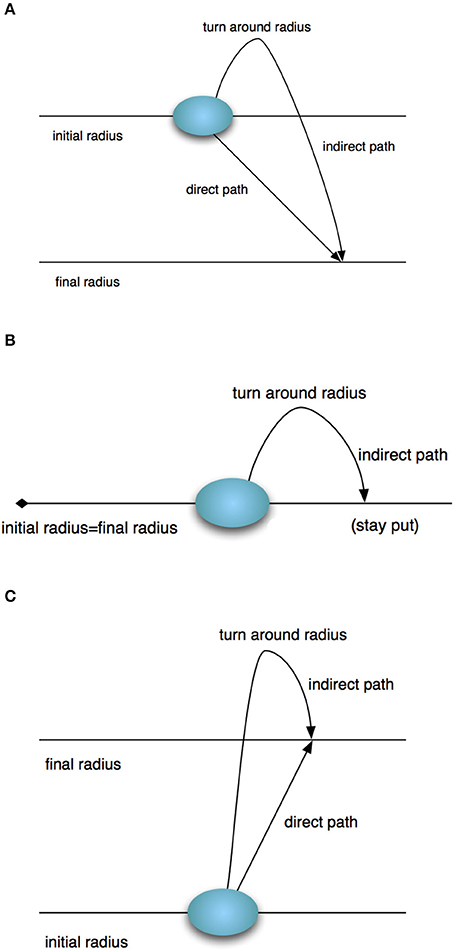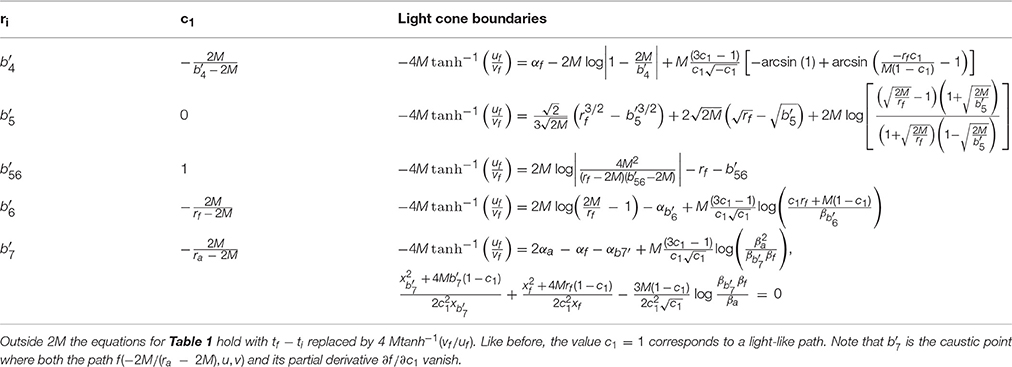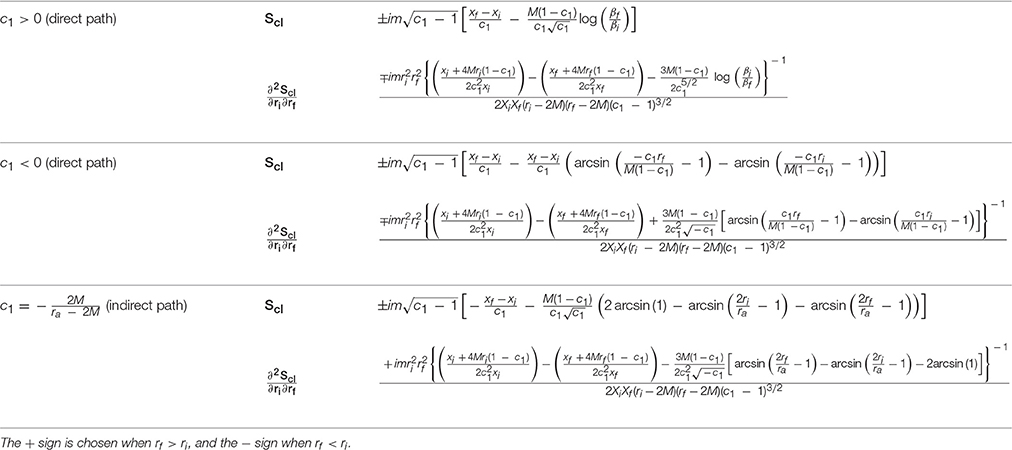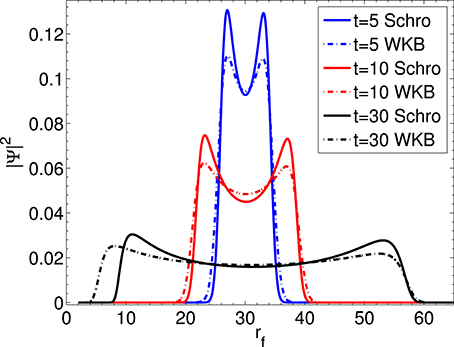Self-Gravitating Stellar Collapse: Explicit Geodesics and Path Integration
- 1Department of Mathematics and Natural Sciences, College of Arts and Sciences, Harris-Stowe State University, St. Louis, MO, USA
- 2Department of Physics, University of Zurich, Zurich, Switzerland
- 3TAPIR, Department of Theoretical Astrophysics, California Institute of Technology, Pasadena, CA, USA
We extend the work of Oppenheimer and Synder to model the gravitational collapse of a star to a black hole by including quantum mechanical effects. We first derive closed-form solutions for classical paths followed by a particle on the surface of the collapsing star in Schwarzschild and Kruskal coordinates for space-like, time-like, and light-like geodesics. We next present an application of these paths to model the collapse of ultra-light dark matter particles, which necessitates incorporating quantum effects. To do so we treat a particle on the surface of the star as a wavepacket and integrate over all possible paths taken by the particle. The waveform is computed in Schwarzschild coordinates and found to exhibit an ingoing and an outgoing component, where the former contains the probability of collapse, while the latter contains the probability that the star will disperse. These calculations pave the way for investigating the possibility of quantum collapse that does not lead to black hole formation as well as for exploring the nature of the wavefunction inside r = 2M.
1. Introduction
Black holes play a pivotal role in the evolution of the universe providing an important test laboratory for general relativity. Within classical general relativity, Oppenheimer and Synder modeled the gravitational collapse of star to a black hole by approximating the star with a uniform sphere of dust (hereafter O-S model) (Oppenheimer and Snyder, 1939). This model provides an analytic solution for stellar collapse that connects the Schwarzschild exterior of a star to a contracting Friedmann-Robertson-Walker (FRW) interior. Once the surface has passed within r = 2M, no internal pressures can halt the collapse and all configurations collapse to a point-like singularity at r = 0. The general features of this toy collapse model have been examined by many authors (Vaidya, 1951; Misner et al., 1973; Singh and Witten, 1997; Goswami and Joshi, 2004; Joshi, 2007).
In the standard formalism from Misner et al. (1973), the stellar surface is considered to be initially at rest. Here we consider configurations with all possible initial velocities. We derive closed-form solutions for the equations of motion in Schwarzschild and Kruskal coordinates for space-like, time-like, and light-like geodesics.
As an example application of our closed-form solutions for the classical O-S model with non-zero initial velocities, we consider the macroscopic collapse of a spherically symmetric sphere of dust composed of ultra-light particles. To approximate quantum effects, the radius of the star is approximated by a Gaussian wavepacket that is initially centered far from r = 2M. Its evolution is then followed via a simple path integral approach that extends the results of Redmount and Suen (1993) from a relativistic free particle to a particle constrained by non-trivial gravity. Gravitational collapse incorporating approximate treatments of quantum mechanics has been considered by a variety of authors (Hájíček et al., 1992; Hawkins, 1994; Casadio and Venturi, 1996; Ansoldi et al., 1997; Berezin, 1997; Zloshchastiev, 1998; Alberghi et al., 1999; Vaz and Witten, 2001; Corichi et al., 2002; Ortíz and Ryan, 2007). They involve non-equivalent ways of quantization that often produce physically different results (Dolgov and Khriplovich, 1997). Our path-integral approach approach is simpler, and can be easily compared to the assumption that the particle obeys the relativistic Schrödinger equation.
In the classical model a star is idealized as a collapsing self-gravitating dust sphere of uniform density and zero pressure where the constituent particles have the attributes of classical dust: each particle is assumed to be infinitesimal in size and to interact only gravitationally with other matter. The inclusion of quantum mechanical effects lifts some of these assumptions allowing for the possibility that some configurations will not collapse to black holes but will disperse or even form stable new configurations. Quantitatively, quantum treatment is necessary in macroscopic stellar collapse when the action S is of the order ℏ (Narlikar, 1977). In our case, the S/ℏ ~ 1 condition corresponds to mM ~ ℏ. For macroscopic black holes of masses , this implies that quantum treatment is necessary for ultra-light constituent particles of m ~ 10−10 − 10−19 eV. In nature, such ultralight particle could be dark matter. Dark matter comes close to the attributes of classical dust, and some dark matter clouds may be dense enough to collapse to black holes. Particles as light as 10−22 − 10−23 eV have been proposed as constituents of dark matter halos (Hu et al., 2000; Lesgourgues et al., 2002; Lundgren et al., 2010; Khmelnitsky and Rubakov, 2014).
To approximate quantum effects of the collapse of such a halo comprised of ultra-light particles, we start with an initial wavefunction that represents the position of the particle on the stellar surface, and is at first far from 2M. To study the propagation of the wavefunction, we integrate over all possible paths taken by the particle. At a given time, the outgoing wavefunction comprises the probability that the star disperses, and the ingoing wavefunction the probability that it collapses. We compute the propagator in analytical form for a particle on the surface of the star in the WKB approximation, and compare this to the limited assumption that the particle obeys the relativistic Schrödinger equation. Our equations reduce to a free particle case when the mass of the star is zero; then the solution to the relativistic Schrödinger equation is the exact representation of the wave function (Redmount and Suen, 1993). In the more general case of a particle on the surface of a star, this representation is no longer correct. However, the comparison is instructive. As expected, we observed that the WKB and relativistic Schrödinger approximations are out of step at early and late times, and appear to converge toward one another at intermediate times.
In Schwarzschild coordinates, we can follow the evolution of the surface of the star only until the formation of an apparent horizon due to the r = 2M coordinate singularity. In Kruskal coordinates, one can continue to study the evolution of the star inside the apparent horizon (r < 2M). The paths we have derived here include time-reversing space-like paths, which allow for the possibility of extraction of information from inside the horizon to the outside. These paths turn inside the horizon r > 0, and head toward r = 2M. In future work, explicit geodesic equations in Kruskal coordinates may be used as a stepping stone to model behavior inside r = 2M.
The rest of the paper is structured as follows: in Section 2 we describe the Oppenheimer–Snyder model. Section 3 includes an overview of the classical action and paths, a computation of the Oppenheimer–Snyder limit and the derivation of the classical paths in Schwarzschild coordinates. Section 4 details the classical paths in Kruskal coordinates, which comprise a starting point for future work that explores the collapse inside r = 2M. As an example application of the closed form geodesics, Section 5 describes the quantum treatment of the dust collapse applicable to ultra-light particles in Schwarzschild coordinates. The conclusions follow in Section 6.
2. The Oppenheimer–Snyder Model
In General Relativity, a first approximation to the exterior space-time of any star, planet or black hole is a spherically symmetric space-time modeled by the Schwarzschild metric. This is a consequence of Birkhoff's theorem (Misner et al., 1973). The Schwarzschild line element thus takes the usual form
where
Throughout this paper we use geometric units with G = c = 1.
The Oppenheimer–Snyder (O-S) model follows the collapse of a star that is idealized as a dust sphere with uniform density and zero pressure from the perspective of an observer located on the surface of the star. The motion of the collapsing surface initially at radius ri can be parametrized by
These equations correspond to Equations (32.10a–32.10c) of Misner et al. (1973). The star collapses to a singularity in finite proper time. However, it takes an infinite Schwarzschild t to reach the apparent horizon at r = 2M and thus an external observer will never see the star passing its gravitational radius (r = 2M).
In Misner et al. (1973) the stellar surface is considered to be initially at rest. Here we integrate the equations of motion for configurations with all possible initial velocities.
3. Classical Action and Radial Geodesics in Schwarzschild Coordinates
The relativistic action S and the Lagrangian for this system are
where τ is the proper time, and = dr/dt. The Lagrangian is
The momentum
and the Hamiltonian is
which reduces to the free particle Hamiltonian in the M → 0 limit. The equation of motion derived from the Euler-Lagrange equations is
which can be integrated to
From this the classical paths are determined
where
The + sign represents motions from ri to rf > ri, and − sign represents the star collapsing from ri to rf < ri. The parameter c1 can be used to separate the space-time regions
In the free particle case (M → 0 in Equation 11), represents the velocity squared of the particle.
3.1. Stellar Surface at Rest Limit
When the surface of the star is initially at rest, initial velocity
From Equation (11), this corresponds to
We can recover our equations of motion for this c1 value from the O-S model. We proceed by taking the derivative of Equations (3) and (5) w.r.t. η
where we used that . We then divide dr/dη by dt/dη, and use ri = 2M(c1 − 1)/c1 from Equation (16) to recover the equation of motion
The negative sign − fits in with our convention for a collapsing star. While some paths will have low probability, a path integral approach that includes quantum effects requires the consideration of space-like, time-like, and light-like paths with all possible initial velocities.
3.2. Classical Paths in Schwarzschild Coordinates
Schwarzschild coordinates allow us to explore the space-time outside r = 2M. The possible paths taken by a particle on the surface of a collapsing star are written explicitly in Table 1. Every point (rf, tf) may be reached either via a direct path or via an indirect path. Table 2 contains the boundary regions that determine whether a path is direct or indirect, and whether it lies inside or outside the light cone.
The table uses
where s = i, f, a.
The direct paths include a logarithmic term when c1 > 0 and an arc sin term when c1 < 0. The indirect paths occur for ri in the b3 − b4 region. They each contain a zero velocity point where the path turns around. Mathematically, the velocity passes through zero (dr/dt = 0 at some radius ra) when x(ra) = 0, which corresponds to c1 = −2M/(ra − 2M). The indirect paths reach the final point (rf, tf) after going through a zero velocity point at ra(ta < tf) with ra > rf and ra > ri. The paths from ri to ra correspond to the positive sign in Equation (12), while the path from ra to rf corresponds to the negative sign.
To understand these paths we make an analogy with the vertical motion of a ball under gravity (See Figure 1). This analogy arises naturally due to the correspondence between the Friedmann equation and the equation of motion for a test particle in the gravitational field of a point mass in Newtonian gravity. It can be made only in the Schwarzschild case because then the interior of the star can be represented by an FRW model, which provides the link to Newtonian gravity.
Consider a ball traveling from point ri (initial radius) to point rf (final radius) with rf below ri. It can either go down directly from ri to rf (direct path) or it can go up from ri, reach its highest point, where its velocity will be zero, and then fall back down to rf (indirect path). This is shown schematically in Figure 1A. Analogously, if a ball has to travel from ri to rf with rf above ri, it can go directly from ri to rf or it can pass above rf, reach its zero velocity point above rf and return down to rf. This case can be seen in Figure 1C. The middle figure (Figure 1B) shows the special case when ri = rf. Then the ball can either stay put or it can be thrown up, reach its higher point, and fall back down. Each of these paths takes a different amount of time to complete. For a fixed travel time Δt, the two points ri and rf are connected by a single path that is either a direct path or a turn-around path. At the turning point of a turn-around path (also its highest point) the speed of the particle is always zero.
If we keep the time interval constant, we find that for a given rf there is a point ri = b4 > rf, where the velocity dr/dt at b4 = 0. Similarly, there is a point ri = b3 < rf such that the velocity dr/dt at rf = 0. For any point ri between b3 and b4, the only way a particle can reach rf in the same time Δt is if it goes through a turning point ra > rf and ra > ri. The particle cannot reach rf > ri if it's velocity vanishes at any point between ri and rf.
The motion toward or away from r = 2M can be compared to the vertical motion of a ball under gravity when thrown straight down or up, respectively. Classically, the star will always collapse to a black hole. Quantum mechanically, we include all possible initial velocities of the surface of the star toward and away from 2M. The wavefunction of a particle on the surface of the star determines the spread of the trajectory of the surface of the star itself.
3.3. Escape Velocity
For a particle of mass m that is thrown up from the surface of the Earth, an initial upward velocity vescape ≥ 11.2 km/s ensures that the particle escapes Earth gravity. At this speed
where ME, and RE are the Earth mass and radius.
We continue with the ball analogy to estimate the escape velocity for our particle. In our case, RE is replaced by the initial radius of the star ri, and vi = dr/dτ. The kinetic energy of the particle on the surface of the star equals its potential energy when
Here
with dr/dt = given by Equation (11). This results in
whose solution is c1 = 0. So, while all outgoing paths with c1 < 0 will turn-around, outgoing paths with c1 ≥ 0 will not have turning points. When c1 = 0, the turning point (dr/dτ|ra = 0, xa = 0) occurs at ra → ∞ as expected for an escaped particle.
The different paths (Table 1) and their various regional boundaries (Table 2) are summarized below for a given (rf, tf) outside r = 2M:
• c1 = 1: the paths are light-like (ds2 = 0) with ri = b1 < rf and ri = b6 > rf. The paths with c1 > 1 are space-like, while those with c1 < 1 are time-like.
• c1 = 0: ri = b2 < rf and ri = b5 > rf. This path defines the escape velocity. All paths with c1 > 0 that are outgoing will not reverse, allowing the particle to escape the gravity of the star.
• c1 = −2M/(rf − 2M): ri = b3 < rf. The minimum value of ri where rf is reached directly with x(rf) = 0 and null final velocity
Paths with ri ≤ b3 are direct. Paths with ri between b3 and b4 are indirect.
• c1 = −2M/(b4 − 2M): ri = b4 > rf. This path starts with zero initial velocity. All paths with ri > b4 are direct.
4. Classical Paths in Kruskal Coordinates
Our study is the first to consider space-like paths in Kruskal coordinates for a particle on the surface of a collapsing star. They have not been explicitly considered before because they are believed to be of low probability. We conjecture that they play an important role in quantum mechanical collapse in the same way the probability of passing through the potential barier is important in tunneling. Classically, it can never happen, and yet this probability cannot be ignored in quantum mechanics.
In this section we derive and discuss the closed-form solutions to the equation of motion for the space-like, light-like and time-like paths in Kruskal coordinates. We find that space-like geodesics have the interesting property that they can turn around outside r = 2M and move back in time. Unlike the Schwarzschild t and r, which are time and space coordinates, respectively, outside r = 2M but switch roles for r < 2M, the Kruskal coordinate v is always a time coordinate and the coordinate u is always a space coordinate. The relation between the Schwarzschild r and t and the Kruskal variables u and v is given by
with
and
Thus the line element in Kruskal coordinates takes the form
The singularity at r = 0 occurs at u2 − v2 = −1. In this paper we consider only the first quadrant u > 0 and v > 0. The horizon r = 2M occurs at u = v. Outside the horizon u > v, whereas inside the horizon u < v.
The classical equation of motion
can be derived from the Euler-Lagrange equations
for the Lagrangian
Note that here .
The equation of motion can be reduced to
where xr is given by Equation (13). Direct paths from ri to rf > ri have the “+”-sign in the numerator and denominator with du/dv > 0. Direct paths from ri to rf with rf < ri will have the “−”-sign in the numerator and denominator.
The classical paths describing the evolution of the star outside r = 2M have been discussed in Sec. 3.2 in Schwarzschild coordinates. It was shown that there were direct space-like and light-like paths as well as direct and indirect time-like paths. Any two points in (r, t) were connected by a unique classical path.
What is new in Kruskal space-time are the turning points in the u − v plane for all space-like, light-like and time-like paths. Spacelike paths (c1 > 1, |du/dv| > 1) turn in time at points when dv/du = 0, whereas timelike paths (c1 < 1, |du/dv| < 1) turn in space when du/dv = 0. Additionally, there are indirect space-like and light-like paths that have turning points in r inside the apparent horizon (here we refer to paths as being indirect when they turn in r; the light-like paths turn at r = 0). In contrast to the time-like paths, the in-going space-like paths are not unique. A point outside r = 2M might be connected to a point inside the apparent horizon via a direct and an indirect space-like path or via two indirect space-like paths.
We determine the regions (Table 3) and the light-cone boundaries (Table 4) that delimit the different kinds of paths that start at (ui, vi = 0) outside the horizon and reach (uf, vf) inside the apparent horizon. Outside the horizon, the light cone boundary values of “ui” for a given uf and vf can be determined by replacing tf − ti in Table 2 by . The boundary values of ri (vi = 0) with rf < 2M, are calculated from the equations in Table 4. Note that uf is a function of vf and rf and ui depends on vi, which is typically taken to be zero, and ri. Thus if one finds ri, this determines ui. The point corresponds to xi = 0 with . The c1 = 0 and c1 = 1 (lightlike) paths that reach points (uf, vf) inside the horizon are used to determine the ri values and , respectively. The value corresponds to xf = 0 with c1 = −2M/(rf − 2M) (turning point at r = rf < 2M, space-like path, c1 > 1). The value of is to be determined by using c1 = −2M/(ra − 2M) (xa = 0, ra < rf < 2M) in the equation of motion. The two unknowns and ra are determined by using the equation of motion and its partial derivative with respect to c1. Both equations are given in Table 4. In the region outside (), there exist no classical paths to (uf, vf).
In Figures 2A,B we trace direct time-like, direct space-like, and indirect space-like trajectories that start at vi = 0 and pass through a fixed point P(uP = 9.995, vP = 10.0) with rP ≈ 0.8M, which is located inside the apparent horizon. Path 1 and path 2 are time-like, and originate at different points outside r = 2M. Path 1 (ui = 2.59, c1 = −1.05) lies in the region of Table 3. Path 2 (ui = 16.15, c1 = 0.8) lies in the region, which contains time-like paths with a turning point in the u − v plane (du/dv = 0) that lies outside the apparent horizon.
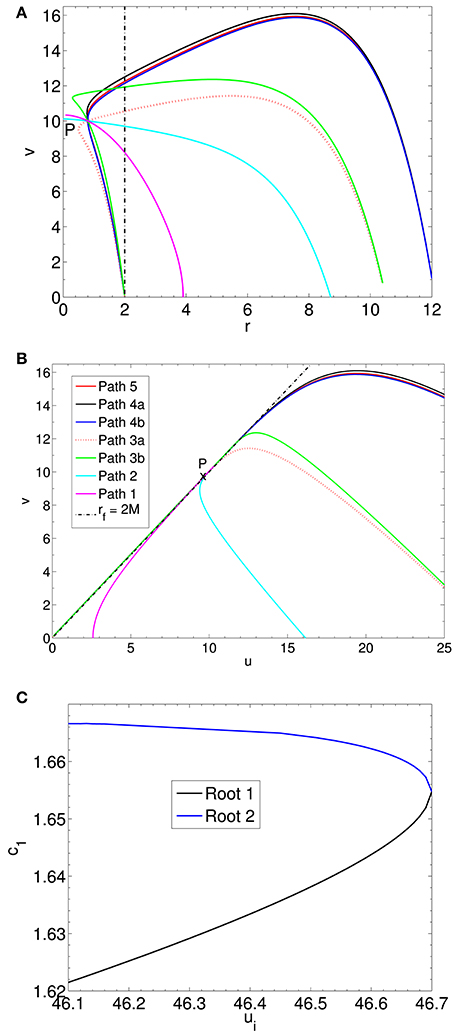
Figure 2. (A) v vs. r and (B) v vs. u are shown for space-like and time-like paths with vi = 0 that pass through P(uP = 9.995, vP = 10.0) of rP = 0.8, a point located inside the apparent horizon. (C) The c1 values for indirect space-like paths in the region between and from which point P can be reached are displayed for each ui. No paths exist beyond , which is where the two roots merge into one.
The next region is , where each point outside the horizon is connected to points inside the horizon by two space-like paths: one direct and one indirect. Path 3a and path 3b originate at the same ui = 27.6 (ri = 10.5M). Path 3a reaches P directly. However, after having passed through P, it turns at ra = 0.48M before reaching the horizon like all space-like paths. Path 3b is indirect turning at ra = 0.3M (ua = 11.3, va = 11.35), and then reaching P on its way back toward the apparent horizon. Both paths also have a v − u turning point outside the apparent horizon where dv/du = 0. After having passed through its v − u turning point, each path moves back in time (the space coordinate u continuously decreases, while the time coordinate v increases up to the turning point and then decreases).
In the region there are two indirect paths that connect the same point outside the horizon to a point inside r = 2M. Paths 4a and 4b connect the point of ui = 46.3 to P. They each have a dv/du = 0 turning point outside the horizon, and also turn in r inside the horizon before reaching P. Path 4a turns at ra = 0.77147 < rP and path 4b turns at ra = 0.79969 < rP. It can be seen that the paths are very close together. As ui increases, the paths in this region become progressively closer until they merge at . Path 5 shows the single indirect path that originates at ui = 46.7 (). Beyond this point, there are no real solutions and hence no way to reach point P.
Figure 2C displays the c1 values of space-like paths reaching point P (uP = 9.995, vP = 10.0) from ui ≥ 46.1 at vi = 0. At first, for each ui in the figure there are two c1 values with which the final point P can be reached. The figure clearly shows the roots (c1 values) coming closer and closer together until they merge at the caustic point . Beyond this point there are no paths that reach point P. Extensions to this work to determine the Kruskal-WKB wavefunction will require an analysis of the caustic at to remove any potential divergences.
The indirect paths connecting (ui, vi) with ri > 2M to (uP, vP) with rP < 2M penetrate the horizon deeper than rP turning at ra < rP before reaching rP (e.g., see the green path in Figure 2A). After turning, all paths must continue toward the apparent horizon reaching it at u = v = 0. These paths move back in time from a point outside the horizon, where dv/du = 0, after having traveled to that point forward in Kruskal time from (ui, vi = 0) with ri > 2M.
As discussed before, the turning points in r correspond to xr = 0 (in the Kruskal paths xr appears in Equation 58). They occur at r = ra when xa = 0, where c1 = − 2M/(ra − 2M). Since c1 > 1 for space-like paths, clearly ra < 2M (the turning points are inside the horizon). For any r on a path with ra as the turning point, xr can be written as . To ensure the non-negativity of the term under the square root all points on this path must have r > ra. By the same token, for time-like paths ra > 2M and r < ra. This case was described in the Schwarzschild analysis.
All space-like paths that reach points inside the horizon subsequently head toward the horizon r = 2M (u = v). Classically, they end at uf = vf = 0. However, quantum mechanically there may be paths close to the classical path that bring information from within the black hole horizon to the outside.
5. Quantum Treatment in Schwarzschild Coordinates
We consider a collapsing cloud of ultra-light particles with mM ~ ℏ. Such particles are not localized and thus neither is the surface of the star. The position of a particle on the surface of the star is then approximated by a wavefunction. In a relativistic path integral approach, this wavefunction can be computed in the WKB approximation via an integral over the classical action (Schulman, 2005). It is necessary to include configurations will all possible initial velocities. For each point (rf, tf) all classical paths derived above are needed. In this paper, we only perform the WKB analysis in Schwarzschild coordinates, where we can only use the paths to rf > 2M.
5.1. WKB Approximation: Closed-Form Propagator, Numerical Wavefunction
In order to study the wavefunction we use a WKB approximation of the propagator
where S is the action associated with each path. The set of paths C include space-like, time-like and light-like paths.
The WKB approximation involves expanding about the classical action Scl to include paths that slightly deviate from the classical paths. The propagator is dominated by paths near the classical trajectory between (ri, ti) and (r, t) and is approximated by the WKB expression (Schulman, 2005)
The WKB wave function is obtained from the integration of the propagator
The initial wavefunction that describes a particle on the surface of a star of radius ri is taken to be a Gaussian centered about rc
with rc >> 2M.
The action from Equation (6) is rewritten using Equations (11) and (13) as
for direct paths connecting (ri, ti) to (rf, tf). The + sign corresponds to rf > ri and the − sign corresponds to rf < ri.
Indirect paths connecting (ri, ti) to (rf, tf) through the turning point (ra, ta) with ra > ri and ra > rf are described by the classical action
In Schwarzschild coordinates, the wavefunction is continuous across all regions outside r = 2M. The presence of the r = 2M coordinate singularity prohibits the inclusion of paths at or beyond the horizon region. Closed-form expressions for Scl and are given in Table 5. Both functions are continuous across all regions outside r = 2M. Once c1 is known for every point (r, t), we have all the ingredients to find the propagator in Equation (34) using the Scl, and expressions from Table 5. The propagator is then integrated to find the wavefunction.
5.2. Relativistic Schrödinger Solution
5.2.1. Free Particle
The M → 0 limit describes a relativistic free particle that is no longer confined by the gravity of the sphere of dust. This case was first studied by Redmount and Suen (1993). We revisit this limit to investigate whether the wavefunction in the WKB approximation converges to the relativistic Schrödinger solution, which is the exact solution for this case. In Redmount and Suen (1993) some disagreement was observed, but while they attempted a physical interpretation, it is likely due to numerical error.
When M → 0, the Hamiltonian from Equation (9) reduces to
where p is now the momentum operator. The Hamiltonian is nonpolynomial in p. The square root term thus corresponds to a non-local momentum operator that is interpreted as acting on any wavefunction (Redmount and Suen, 1993)
to give
This integrates to
When Δt = 0, we recover the original wavefunction, which is chosen to be a Gaussian centered around the origin,
and so
The normalization is time independent.
In terms of the propagator
where
Here K1 is the modified Bessel function and . When Δt = 0 the propagator reduces to δ(Δx) as expected.
The WKB propagator for the relativistic free particle is then computed using Equation (34) Redmount and Suen (1993)
where WKB wavefunction is given by
The integrals from Equations (44) and (47) are evaluated numerically. The results are shown in Figure 3. It can be seen that the wavefunction in the WKB approximation converges to the Schrödinger solution in all parts of the light cone. When no star M is present, the relativistic Schrödinger is exact as originally discussed in Redmount and Suen (1993). However, when they performed the same numerical comparison, they found some disagreement between the two solutions. This we believe to be due to numerical error of Redmount and Suen (1993). We observe convergence (see Figure 3). of the wavefunction in the WKB approximation to the Schrödinger solution in the M → 0 limit.
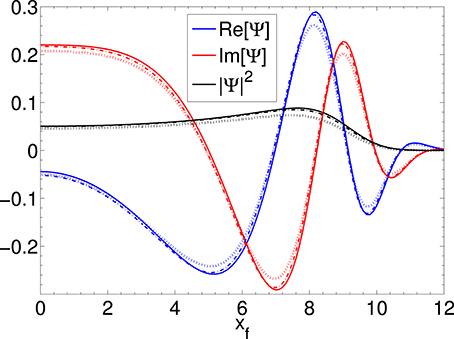
Figure 3. Re[Ψ], Im[Ψ], and |Ψ|2 are shown for the free particle case at t = 10ℏ/m as a function of xf, which also has units of ℏ/m. The solid lines show the Schrödinger solution, while dotted lines and dashed lines show the WKB approximation for ϵ = 0.05, ϵ = 0.005, respectively. It can be seen that as ϵ → 0 the WKB approximation converges to the Schrödinger solution.
5.2.2. Non-zero Mass
While in the free particle case the Schrödinger solution was exact, when M ≠ 0 it becomes a rough approximation, which fails as we approach r = 2M. Comparing the two solutions is still instructive. If we follow the same procedure as for the free particle above, and re-write the Hamiltonian from Equation (9) as
where p is the momentum operator and
The whole wavefunction can then be written as
where the propagator is given by
Like before, the propagator can then be integrated exactly to obtain
where K1 is the modified Bessel function and
When r → 2M the propagator vanishes. Thus this solution is inaccurate at late times and cannot model the final stages of the collapse of the dust sphere.
5.3. Numerical Results
We integrate Equation (35) numerically for the Gaussian wavefunction from Equation (36) centered about rc = 30M. Classically, the star collapses to r = 2M in infinite Schwarzschild time. However, quantum mechanically there is a possibility for the star expanding and dispersing as well. Figure 4 shows the time evolution from t = 0 to t = 45M of as a function of rf. An ingoing peak and an outgoing peak appear with the amplitude of the ingoing peak always remaining larger than that of the outgoing peak for the course of the evolution, which is expected for a collapsing star. For numerical computations we scale all variables to be dimensionless. The only parameter is mM/ℏ. We note that Figure 4 is qualitatively similar to the WKB results of Corichi et al. (2002).
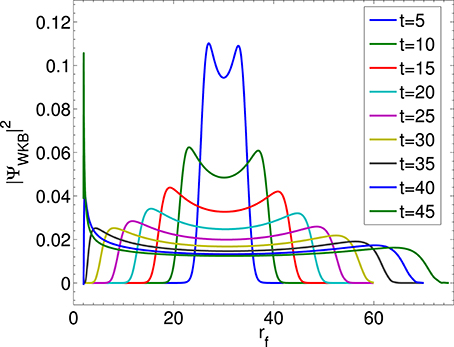
Figure 4. The time evolution of WKB is shown from t = 5M to t = 45M in the case of mM/ℏ = 1. We can see that the star collapses to a black hole.
Figures 5A,B show the ingoing and outgoing peaks of for different values of mM/ℏ at times of tf = 5M and tf = 10M, respectively. For a given particle number N = M/m, the speed of the collapse increases slightly with the particle mass m as does the value of the ingoing peak. This is consistent with our expectation that for higher particle mass the star is more classical. For lower masses, the star resists collapse longer until probability of dispersion exceeds the probability of collapse.
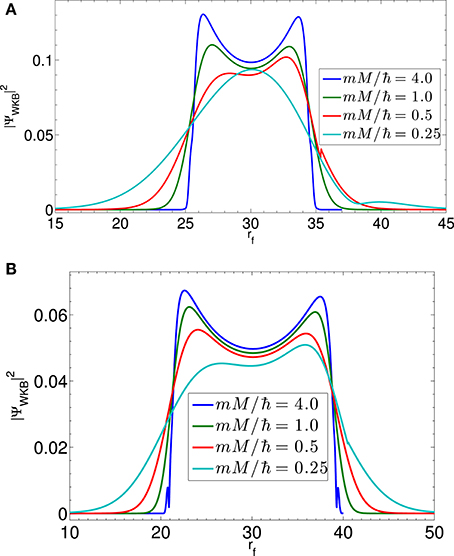
Figure 5. (A) at t = 5M as a function of rf for mM/ℏ = 4.0, mM/ℏ = 1, mM/ℏ = 0.5, and mM/ℏ = 0.25. It can be seen that that lower masses behave more quantum mechanically, and are less likely to collapse to a black hole. (B) at t = 10M as a function of rf for the same masses.
In Figure 6 we compare the WKB and Schrödinger solutions. It can be seen that the radial position of the ingoing peak drifts out of step at late times, while the outgoing peak continues to evolve at about the same position. As the star approaches rf = 2M, the ingoing peak amplitude for the WKB approximation increases developing a numerical singularity that indicates the formation of an apparent horizon, while the ingoing peak amplitude of the Schrödinger solution decreases since the propagator in Equation (52) vanishes at rf → 2M. The latter behavior reinforces that the relativistic Schrödinger equation is not the correct representation for a particle in the gravitational field of a collapsing star.
6. Conclusion
Closed form solutions for the classical paths taken by a particle on the surface of a collapsing star have been determined for all initial configurations in Schwarzschild and Kruskal coordinates.
We found that
(i) all time-like paths are unique. For a given time interval, a path between an initial and final point can be either direct or indirect, where it turns around in space. Thus some particles that initially move away from the star, can return and contribute to the collapse.
(ii) all space-like paths are unique outside r = 2M.
(iii) Kruskal space-like paths can turn around in Kruskal time, but cannot turn in Kruskal space. Multiple paths can connect a given point outside the horizon to a final point that lies inside r = 2M.
(iv) Classical Kruskal space-like paths connect points outside r = 2M with points inside r = 2M up to a critical value of r = ra. Spacelike paths from (ri, vi = 0) to any given point r inside the horizon, where ra < r < 2M, are non-unique (two paths exist). These paths get less and less separated and merge into a single space-like path at r = ra and any point r < ra is unreachable from ri. Upon reaching the critical value r = ra, the space-like paths turn back toward r = 2M, reaching it at u = v = 0. Therefore, classically, no information from r < 2M can exit a black hole. However, by taking into account paths close to the classical paths, one might be able to extract information from r < 2M.
If we make an analogy to tunneling, the particle has a low probability of passing through a potential barier. Classically, it never happens, and yet this probability cannot be ignored in quantum mechanics. Similarly, it may be that the low probability space-like paths will play a crucial role in our understanding of quatum mechanical collapse.
The collapse of a self-gravitating star was next modeled as a ball of dust using a WKB approximation. We integrated around the classical paths with all possible initial velocities to include quantum effects. This extended the analysis of Redmount and Suen (1993) from the relativistic free particle to the case of non-trivial gravity. In practice, quantum mechanical effects are important in macroscopic stellar collapse when the sphere is composed of ultra-light particles. A number of ultralight dark matter particles have been proposed, which could physically motivate such stars.
The evolution of the wavefunction of a particle on the surface of a collapsing star was followed numerically. We showed that in the case of a star collapsing with zero initial velocity, our path equations reduce to the Oppenheimer-Schneider equations of motion. In the M → 0 limit, the relativistic free particle wavefunction of Redmount and Suen (1993) is obtained, and the WKB and relativistic Schrödinger solutions match. Since in this limit the Schrödinger solution is exact (Kiefer and Singh, 1991), the covergence of the WKB to the Schrödinger solution enforces the validity of the WKB approximation.
Our results for this self-gravitating collapse are summarized as follows:
(i) The wavefunction representing a particle on the surface of a collapsing star typically exhibits an outgoing and an ingoing component, where the former contains the probability that the star will disperse and the latter the collapse probability. For a given particle number N = M/m, we find that the rate at which collapse occurs increases with particle mass. This is consistent with the expectation that for higher particle mass the star is more classical. As the particle mass is lowered, the star resists collapse until the probability that it disperses exceeds the collapse probability. Note that some part of the star always disperses even when a black hole forms.
(ii) In the case of the collapsing star the relativistic Schrödinger solution is not a good approximation for the wave function. On comparing the WKB and relativistic Schrödinger solutions, we find that the ingoing wavefunction gets more and more out of step at late times. The outgoing component of the wavefunction for the two solutions is in better agreement because it is further from the coordinate singularity at r = 2M. As expected, the Schrödinger and WKB solutions are out of step at early times when WKB solution is more inaccurate, they come closer together at intermediate times, and fall out of step again at late times, when the Schrödinger approximation fails to model the singularity formation. The presence of the coordinate singularity at r = 2M, motivate a potential investigation beyond r = 2M via the WKB approximation deployed in Kruskal coordinates where no analytical relativistic Schrödinger solution is available.
The traditional Oppenheimer Schneider model describes the zero pressure collapse of a star starting from rest. We use a path integral approach that requires including paths of all velocities. For a particle on the surface of a star, we explicitly parametrically describe all such paths of different initial velocities. This is done in Schwarzschild coordinates until r = 2M and in Kruskal coordinates until the r = 0 singularity. We include ingoing and outgoing velocities, and time-like, light-like and space-like paths. In the process we have generated the paths shown in Fuller and Wheeler (1962) and more. We have determined equations for the space-like caustics (degenerate paths) which have not been described before in this manner. We have used a WKB path integral approach and determined the Schwarzschild wave function for the collapse. Using a similar approach one can in the future use the parametric path equations we have determined in Kruskal coordinates to explore the space-time inside the horizon. It will require expansion around the caustic. The possibility of paths moving back in time might have important ramifications.
It has long been argued whether quantum gravity should be causal or not (Teitelboim, 1983; Hartle and Kucha, 1986; Hartle, 1988; Mattingly, 2005) and as of today there is no accepted theory of quantum gravity. We evaluate the propagator both for a free relativistic particle, where we have an exact solution, and for a collapsing ball of dust. Since the propagator does not vanish outside the light cone, we include all paths in our integration. In the free particle case, the WKB and exact solutions match. Space-like classical paths give the dominant contribution in the construction of the WKB approximation far outside the light cone, where the approximation is valid. This propagation will be acausal (backward in time) in some Lorentz frames. Whether or not this proves to be admissible in the ultimate theory of quantum gravity is beyond the purpose of our work. Our work's exploration of the consequence of an acausal propogator in the collapse of a zero pressure star might nevertheless contribute to the dialogue in the search of a consistent theory of quantum gravity.
In addition, we propose that an understanding of these low probability paths that are traditionally ignored could shed some light in theories of black hole formation. Furthermore, if the black holes observed by LIGO are formed from scalar particles (Abbott et al., 2016), the particles would be very light; then quantum effects might play a role in their formation, constraining analog gravity theorems (Barceló et al., 2005).
Author Contributions
All authors listed, have made substantial, direct and intellectual contribution to the work, and approved it for publication.
Conflict of Interest Statement
The authors declare that the research was conducted in the absence of any commercial or financial relationships that could be construed as a potential conflict of interest.
Acknowledgments
JB acknowledges Prof. Wai-Mo Suen for the initial impetus to approach this research and for subsequent guidance and useful discussions. We also thank Prof. Ian Redmount for his inital work on this topic. Further, we are particularly grateful to Prof. Mihai Bondarescu and Prof. Philippe Jetzer for useful discussions and advice. RB has received support from the Dr. Tomalla Foundation and the Swiss National Science Foundation. CM is supported by the NSF Astronomy and Astrophysics Postdoctoral Fellowship under award AST-1501208.
References
Abbott, B., Abbott, R., Abbott, T. D., Abernathy, M. R., Acernese, F., et al. (2016). Astrophysical implications of the binary black hole merger gw150914. Astrophys. J. Lett. 818:L22. doi: 10.3847/2041-8205/818/2/L22
Alberghi, G., Casadio, R., Vacca, G., and Venturi, G. (1999). Gravitational collapse of a shell of quantized matter. Class. Quantum Grav. 16, 131.
Ansoldi, S., Aurilia, A., Balbinot, R., and Spallucci, E. (1997). Classical and quantum shell dynamics, and vacuum decay. Class. Quantum Grav. 14, 2727. doi: 10.1088/0264-9381/14/10/004
Barceló, C., Liberati, S., and Visser, M. (2005). Analogue gravity. Living Rev. Relativ. 8, 214. doi: 10.12942/lrr-2005-12
Casadio, R., and Venturi, G. (1996). Semiclassical collapse of a sphere of dust. Class. Quantum Grav. 13, 2715.
Corichi, A., Cruz-Pacheco, G., Minzoni, A., Padilla, P., Rosenbaum, M., Ryan, M. Jr., et al. (2002). Quantum collapse of a small dust shell. Phys. Rev. D 65:064006. doi: 10.1103/PhysRevD.65.064006
Dolgov, A., and Khriplovich, I. (1997). Properties of the quantized gravitating dust shell. Phys. Lett. B 400, 12–14. doi: 10.1016/S0370-2693(97)00352-3
Fuller, R. W. Wheeler, J. A. (1962). Causality and multiply connected space-time. Phys. Rev. 128:919. doi: 10.1103/PhysRev.128.919
Goswami, R., and Joshi, P. S. (2004). Spherical dust collapse in higher dimensions. Phys. Rev. D 69:044002. doi: 10.1103/PhysRevD.69.044002
Hájíček, P., Kay, B. S., and Kuchar, K. V. (1992). Quantum collapse of a self-gravitating shell: equivalence to coulomb scattering. Phys. Rev. D 46:5439. doi: 10.1103/PhysRevD.46.5439
Hartle, J. B. (1988). Quantum kinematics of spacetime. II. a model quantum cosmology with real clocks. Phys. Rev. D 38:2985.
Hartle, J. B., and Kucha, K. V. (1986). Path integrals in parametrized theories: the free relativistic particle. Phys. Rev. D 34:2323.
Hu, W., Barkana, R., and Gruzinov, A. (2000). Fuzzy cold dark matter: the wave properties of ultralight particles. Phys. Rev. Lett. 85, 1158–1161. doi: 10.1103/PhysRevLett.85.1158
Joshi, P. S. (2007). Gravitational Collapse and Spacetime Singularities. Cambridge, UK: Cambridge University Press.
Khmelnitsky, A., and Rubakov, V. (2014). Pulsar timing signal from ultralight scalar dark matter. J. Cosmol. Astropart. Phys. 2014:019. doi: 10.1088/1475-7516/2014/02/019
Kiefer, C., and Singh, T. P. (1991). Quantum gravitational corrections to the functional schrödinger equation. Phys. Rev. D 44:1067.
Lesgourgues, J., Arbey, A., and Salati, P. (2002). A light scalar field at the origin of galaxy rotation curves. New Astron. Rev. 46, 791–799. doi: 10.1016/S1387-6473(02)00247-6
Lundgren, A. P., Bondarescu, M., Bondarescu, R., and Balakrishna, J. (2010). Lukewarm dark matter: bose condensation of ultralight particles. Astrophys. J. Lett. 715:L35. doi: 10.1088/2041-8205/715/1/L35
Mattingly, D. (2005). Modern tests of lorentz invariance. Liv. Rev. Relativ. 8:5. doi: 10.12942/lrr-2005-5
Misner, C. W., Thorne, K. S., Wheeler, J. A., and Gravitation, W. (1973). Freeman and Company. San Francisco, CA: W.H. Freeman.
Narlikar, J. (1977). Quantum uncertainty in the final state of gravitational collapse. Nature 269:129.
Oppenheimer, J. R., and Snyder, H. (1939). On continued gravitational contraction. Phys. Rev. 56:455.
Ortíz, L., and Ryan, M. Jr. (2007). Quantum collapse of dust shells in 2 + 1 gravity. Gen. Relativ. Gravit. 39, 1087–1107. doi: 10.1007/s10714-007-0458-7
Redmount, I. H., and Suen, W.-M. (1993). Path integration in relativistic quantum mechanics. Int. J. Mod. Phys. A 8, 1629–1635. doi: 10.1142/S0217751X93000667
Schulman, L. S. (2005). Techniques and Applications of Path Integration. Mineola, NY: Courier Dover Publications.
Singh, T., and Witten, L. (1997). Spherical gravitational collapse with tangential pressure. Class. Quantum Grav. 14:3489.
Teitelboim, C. (1983). Causality versus gauge invariance in quantum gravity and supergravity. Phys. Rev. Lett. 50:705.
Vaidya, P. (1951). Nonstatic solutions of einstein's field equations for spheres of fluids radiating energy. Phys. Rev. 83:10.
Vaz, C., and Witten, L. (2001). Quantum black holes from quantum collapse. Phys. Rev. D 64:084005. doi: 10.1103/PhysRevD.64.084005
Keywords: ultra-light particles, black hole formation, quantum effects, self-gravitating stellar collapse, geodesics inside black holes
Citation: Balakrishna J, Bondarescu R and Moran CC (2016) Self-Gravitating Stellar Collapse: Explicit Geodesics and Path Integration. Front. Astron. Space Sci. 3:29. doi: 10.3389/fspas.2016.00029
Received: 24 August 2016; Accepted: 08 November 2016;
Published: 25 November 2016.
Edited by:
Martin Anthony Hendry, University of Glasgow, UKCopyright © 2016 Balakrishna, Bondarescu and Moran. This is an open-access article distributed under the terms of the Creative Commons Attribution License (CC BY). The use, distribution or reproduction in other forums is permitted, provided the original author(s) or licensor are credited and that the original publication in this journal is cited, in accordance with accepted academic practice. No use, distribution or reproduction is permitted which does not comply with these terms.
*Correspondence: Christine C. Moran, corbett@tapir.caltech.edu
 Jayashree Balakrishna1
Jayashree Balakrishna1  Ruxandra Bondarescu
Ruxandra Bondarescu Christine C. Moran
Christine C. Moran

